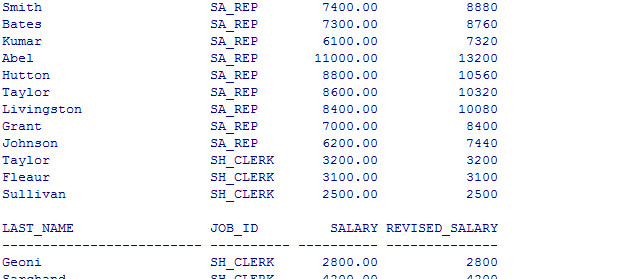单 行 函 数
•操作数据对象
•接受参数返回一个结果
•只对一行进行变换
•每行返回一个结果
•可以转换数据类型
•可以嵌套
•参数可以是一列或一个值


大小写控制函数:这类函数改变字符的大小写


在查询表中的记录时,条件为字符串,而字符串是区分大小写的当不知道是大写还是小写的时候,只要是是同一个字母就可以时,那么可以使用大小写函数

查询结果是:(符合字母,不管是大写还是小写都可以查询的出来了)



字符控制函数:这类函数控制字符
select concat('Hello','World'),substr('HelloWorld',1,5), length('HelloWorld'),instr('HelloWorld','W') from dual

concat:表示连接两个字符
substr:第一个数表示开始数,SQL中开始是从1算起,java是从0算起,第二个参数个数,所以表示从第一个字符开始获取,获取5个字符
length:判断字符串的长度
instr:某个字符在字符串中的位置,从1算起,如果没有返回0
select employee_id,last_name,lpad(salary,10,'*') from employees

lpad:(右对齐)表示总共显示10位,前面为0的拿在第三个参数中指定的符号替换
select employee_id,last_name,rpad(salary,10,'*') from employees

rpad:(左对齐)
select trim('h' from 'hfjdkahfdh') from dual

select trim('H' from 'HfjdkahfdHHH') from dual

trim:表示取出两端所有指定的字符,区分大小写
select replace('abcd','b','m') from dual

select replace('abbcdb','b','m') from dual

replace:替换
数字函数:
ROUND: 四舍五入
select round(45.923,2),round(45.923,0),round(45.923,-1) from dual

第二个参数表示保留多少位小数,可以为负数,也不可以不写,不写默认是0
TRUNC: 截断
select trunc(45.923,2),trunc(45.923,0),trunc(45.923,-1) from dual

第二个参数表示保留 多少位数,多余的不要
MOD: 求余
select mod(1100,200) from dual

表示1100模于200
select last_name,salary,mod(salary,5000) from employees where job_id='SA_REP'

日 期:Oracle 中的日期型数据实际含有两个值: 日期和时间
函数SYSDATE 返回:日期和时间
日期的数学运算
在日期上加上或减去一个数字结果仍为日期。
两个日期相减返回日期之间相差的天数。
–日期不允许做加法运算,无意义
可以用数字除24来向日期中加上或减去天数。



select last_name,months_between(sysdate,hire_date) from employees

select add_months(sysdate,2),add_months(sysdate,-3),next_day(sysdate,'星期日') from dual

select last_day(sysdate) from dual

select round(sysdate,'month'),round(sysdate,'mm'),trunc(sysdate,'hh') from dual


隐式数据类型转换:Oracle 自动完成下列转换


显式数据类型转换

TO_CHAR函数对日期的转换

格式:
•必须包含在单引号中而且大小写敏感。
•可以包含任意的有效的日期格式。
•日期之间用逗号隔开。

select to_char(sysdate,'yyyy-mm-dd hh:mm:ss') from dual

select last_name,to_char(hire_date,'yyyy"年"mm"月"dd"日"') from employees where to_char(hire_date,'yyyy"年"mm"月"dd"日"')='1994年06月07日'

TO_CHAR函数对数字的转换


select to_char(1234567.54,'999,999,999.99') from dual

select to_char(1234567.54,'000,000,000.00') from dual

格式化的时候加上货币符号
select last_name,to_char(salary,'$000,000,000.00') from employees

select last_name,to_char(salary,'L000,000,000.00') from employees

TO_NUMBER 函数对字符的转换


通用函数:这些函数适用于任何数据类型,同时也适用于空值
•NVL (expr1, expr2)
•NVL2 (expr1, expr2, expr3)
•NULLIF (expr1, expr2)
•COALESCE (expr1, expr2, ..., exprn)
NVL 函数:将空值转换成一个已知的值.可以使用的数据类型有日期、字符、数字。
函数的一般形式:
–NVL(commission_pct,0)
–NVL(hire_date,'01-JAN-97')
–NVL(job_id,'No Job Yet')
求公司员工的年薪(含commission_pct)(年薪是12个月的工资乘以奖金率,因为有些员工没有奖金率,所以当乘以奖励率时,没有奖金的员工就变成0了 所以使用该函数)
select employee_id,last_name,salary*12*(1+nvl(commission_pct,0)) "annual_sal" from employees

输出last_name,department_id,当department_id为null时,显示‘没有部门’。(这里department_id是数值型的,而'显示部门是字符型',所以要转换一个数值类型,变成统一类型,这里转换department_id)
select last_name,nvl(to_char(department_id,'999999'),'没有部门') from employees

使用NVL2 函数:NVL2 (expr1, expr2, expr3) : expr1不为NULL,返回expr2;为NULL,返回expr3。

select last_name,salary,commission_pct, nvl2(commission_pct,'sal+comm','sal') "income" from employees where department_id in (50,80)

查询员工的奖金率,若为空,返回0.01,若不为空,返回实际奖金率+0.015
select last_name,salary,commission_pct, nvl2(commission_pct,commission_pct+0.15,0.01) "income" from employees where department_id in (50,80)

NULLIF 函数:NULLIF (expr1, expr2) : 相等返回NULL,不等返回expr1


select first_name,length(first_name) "expr1", last_name,length(last_name) "expr2", nullif(length(first_name),length(last_name)) result from employees

COALESCE 函数
COALESCE 与 NVL 相比的优点在于 COALESCE 可以同时处理交替的多个值。
如果第一个表达式为空,则返回下一个表达式,对其他的参数进行COALESCE 。
select last_name,coalesce(commission_pct,salary,10) comm from employees order by commission_pct

条件表达式
在 SQL 语句中使用IF-THEN-ELSE 逻辑
使用两种方法:
–CASE 表达式
–DECODE 函数
CASE 表达式:
查询部门号为 10, 20, 30 的员工信息, 若部门号为 10, 则打印其工资的 1.1 倍, 20 号部门, 则打印其工资的 1.2 倍, 30 号部门打印其工资的 1.3 倍数
select employee_id,last_name,department_id,case department_id when 10 then salary*1.1 when 20 then salary*1.2 else salary*1.3 end new_sal from employees where department_id in(10,20,30)

select last_name,job_id,salary, case job_id when 'IT_PROG' then 1.10*salary when 'ST_CLERK' then 1.15*salary when 'SA_REP' then 1.20*salary else salary end "revised_salary" from employees

DECODE 函数


select employee_id,last_name,department_id,decode(department_id, 10,salary*1.1, 20,salary*1.2, salary) new_sal from employees where department_id in(10,20,30)

嵌套函数:

•单行函数可以嵌套。
•嵌套函数的执行顺序是由内到外。

打印出 "2009年10月14日 9:25:40" 格式的当前系统的日期和时间.(注意: 使用双引号向日期中添加字符)
select to_char(sysdate,'yyyy"年"mm"月"dd"日" hh:mi:ss') from dual

格式化数字: 1234567.89 为 1,234,567.89
select to_char(1234567,'999,999,999.99') from dual

字符串转为数字时
1). 若字符串中没有特殊字符, 可以进行隐式转换:
select '12345.432'+100 from dual

2). 若字符串中有特殊字符, 例如 '1,234,567.89', 则无法进行隐式转换, 需要使用 to_number() 来完成
select to_number('1,234,567.89','999,999,999.99')+100 from dual

对于把日期作为查询条件的查询, 一般都使用 to_date() 把一个字符串转为日期, 这样可以不必关注日期格式
select last_name, hire_date from employees where hire_date = to_date('1998-5-23', 'yyyy-mm-dd') -- where to_char(hire_date,'yyyy-mm-dd') = '1998-5-23'

转换函数: to_char(), to_number(), to_date()
查询每个月倒数第 2 天入职的员工的信息.
select last_name, hire_date from employees where hire_date = last_day(hire_date) - 1

计算公司员工的年薪
--错误写法: 因为空值计算的结果还是空值 select last_name, salary * 12 * (1 + commission_pct) year_sal from employees

--正确写法 select last_name, salary * 12 * (1 + nvl(commission_pct, 0)) year_sal from employees

查询部门号为 10, 20, 30 的员工信息, 若部门号为 10, 则打印其工资的 1.1 倍, 20 号部门, 则打印其工资的 1.2 倍, 30 号部门打印其工资的 1.3 倍数
--使用 case-when-then-else-end select last_name, department_id, salary, case department_id when 10 then salary * 1.1 when 20 then salary * 1.2 when 30 then salary * 1.3 end new_sal from employees where department_id in (10, 20, 30)

--使用 decode select last_name, department_id, salary, decode(department_id, 10, salary * 1.1, 20, salary * 1.2, 30, salary * 1.3 ) new_sal from employees where department_id in (10, 20, 30)

显示系统时间(注:日期+时间)
select to_char(sysdate,'yyyy-mm-dd hh:mi:ss') from dual

--查询员工号,姓名,工资,以及工资提高百分之20%后的结果(new salary) select employee_id,last_name,salary,salary*1.2 "new salary" from employees

--将员工的姓名按首字母排序,并写出姓名的长度(length) select last_name,length(last_name) from employees order by last_name asc

--查询各员工的姓名,并显示出各员工在公司工作的月份数(worked_month) select last_name,hire_date,round(months_between(sysdate,hire_date),1) "worked_month" from employees

--查询员工的姓名,以及在公司工作的月份数(worked_month),并按月份数降序排列 select last_name,hire_date,round(months_between(sysdate,hire_date),1) "worked_month" from employees order by "worked_month" desc
注意:需要加上双引号


select last_name || ' earsn ' || to_char(salary,'$999999') || ' monthly but wants ' || to_char(3*salary,'$999999') "Dream Salary" from employees


select last_name "Last_name",job_id "Job_id", decode(job_id, 'AD_PRES','A', 'ST_MAN','B', 'IT_PROG','C', 'SA_REP','D', 'ST_CLERK','E') "Grade" from employees

用case函数
select last_name "Last_name",job_id "Job_id",case job_id when 'AD_PRES'then 'A' when 'ST_MAN' then 'B' when 'IT_PROG' then 'C' when 'SA_REP' then 'D' when 'ST_CLERK' then'E' end "Grade" from employees




